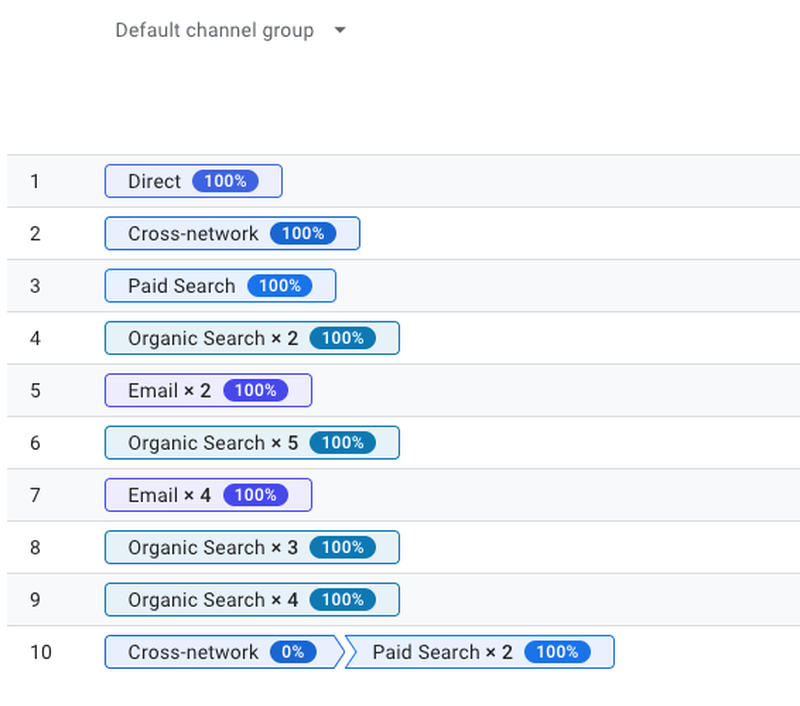
User research data proves when people complete an action on a website, such as a purchase, only 40% to 50% of these people complete this buying journey in their first session with a retailer. This means approximately 50% to 60% of people complete multiple visits to site before purchasing online (or in store).
This multi-visit buying behaviour has come from my direct analysis of hundreds of millions of datasets across hundreds of retailer's sites around the world.
Understanding this common consumer behaviour is relevant when it comes to the importance of tracking the value of your Digital Marketing investment.
Without Attribution you only see 50% of your Marketing Investment:
From a marketing mix tracking perspective, you will only be able to get accurate performance data for 40% to 50% of your marketing investment.
Why?
Because GA4 (and GA Universal) conduct what is called "Last Click" tracking for conversions (sales). These analytical tools give credit to the online marketing channel that resulted in a conversion which occurred in that session.
Remember the old-school Marketing saying,
"I know 50% of my marketing investment worked, but I don't know which 50%"
Well this is now the case for tracking the effectiveness of Digital Marketing campaigns without Attribution modeling.
Definition of "Attribution Modeling":
The ability to create a measurement system that defines how to give credit for sales across every touch point the consumer interacts with that is fully under the control of the retailer or the retailer's digital eco-system.
As a starting point, these touchpoints are defined in two ways...
- The content and pages on the site the consumer engages with to reach a sale.*
- All Digital Marketing channels the consumer used to find and reach the retailer: Paid, Organic, Social, Email etc...
*Understanding the journeys a consumer undertakes (on your site) is a form of Attribution Modeling which is why Page Value metrics are important. Read this recent article on the importance of Page Value data.
When it comes to marketing channels, while many marketers are familiar with the concept of Attribution Modeling, very few businesses truly understand how blind they are to this crucial insight.
Consumer "Multi-visit" Behaviour - an example:
Let me breakdown the issue by explaining a common scenario that I have seen millions of times occurring in Retailer and B2B behavioural data. I call it the "consumer multi-visit" buying behaviour...
- A consumer searches for a product in Google and sees your Paid Search link.
- The consumer clicks the link and is taken to your site.
- The consumer engages with the site but did not complete a purchase in that session. He/she ended the session: there are many reasons why this happens.
- Later that day, the consumer comes back to your site, but this time they typed in your brand name into Google, clicked on an organic link.
- During this second session, the consumer completed a purchase.
In the above scenario, Google Analytics will give Organic Search credit for the sale that occurred in the second session. This is called "Last Click Attribution".
But Marketers need to know about the influence the Paid Search campaign had in getting this consumer to the site in the first session. This is valuable insight.
Retailers and B2B's are blind:
Despite the importance of this type of insight, this layer of tracking is not available in GA4.
GA4 has a section titled "Attribution" but it's simple and not set up in a way that helps retailers understand the types of scenarios like the example above.
The image in Figure 1 below shows what is available in GA4 RE Attribution data. This report shows the combination of Digital traffic channels that work together to produce online transactions. There is no level of granularity available that gives Retailer's tangible data which defines specific campaigns that add value.
Also recognise GA4's use of generic labels for marketing channels: "Cross-network" (Google's Performance Max) and "Paid Search". Retailers can do nothing with this information.

Figure 1
It is important to note, there is a version of the above report that is "Campaign-specific" but this data is presented at an altitude that still does not give the granularity needed to drive the right type of change to Digital Marketing channels.
Conclusion:
Retailers and B2B's need to do three things....
- Collaborate with a Business Strategist who understands your business strategy and can produce a "Data Mining Plan" that defines the measurement system needed to educate the business on what is happening and produce insights that drive the right change.
- This plan is then submitted to GA Geeks who execute the approved plan.
- The business then learns how to use this data to inform change.
Setting up Attribution Modeling becomes the foundation to the plan.
Businesses need to own this first-party data for its site and all Digital Marketing investments. And for those of you who rely on your Digital Marketing Agency for Attribution Modeling: don't. It will be biased.
This article was as tagged as